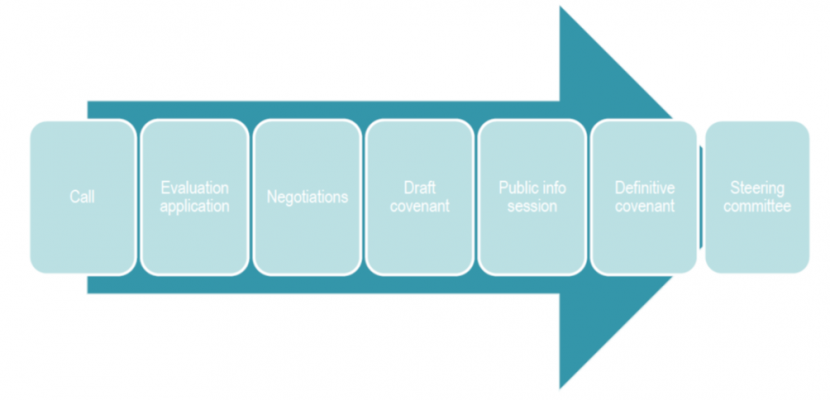Image

Brownfieldcovenants as an instrument to revitalize former landfill sites
Published on 11 September 2019

Belgium
Région de Bruxelles-Capitale/ Brussels Hoofdstedelijk Gewest
This is the good practice's implementation level. It can be national, regional or local.
About this good practice
Reallocation of industrial activities sometimes resulted in abandoned or under used sites, also known as brownfields. The Brownfield Covenant Act (March 22, 2007) offers developers the opportunity to sign a contract with the Government of Flanders and other private and public stakeholders containing mutual commitments to the realization of a brownfield project. This contract is the result of a process for gaining the (public) support and the cooperation of all the stakeholders involved.
Quite often, brownfields include former landfills and even stand-alone landfills could be regarded as brownfields. OVAM identified about 3.300 former landfill. Since 2017, specific calls for the brownfield redevelopment of former landfills were launched. This procedure facilitates land owners and developers to revitalize such landfill sites.
A negotiator is appointed by the Flemish government in order to streamline this process. He/she sets up a platform where actors and stakeholders could meet and discuss the plans. This multi-actor governance is not limited to public actors at several levels (local, regional, federal) but also civil society is involved. After approval, a covenant is signed and a steering committee installed (chaired by the negotiator) in order to follow up the progress and tackle the problems.
The overarching programme is coordinated by the Brownfield Board, consisting of the CEOs of the involved governmental agencies and representatives of the ministers.
Quite often, brownfields include former landfills and even stand-alone landfills could be regarded as brownfields. OVAM identified about 3.300 former landfill. Since 2017, specific calls for the brownfield redevelopment of former landfills were launched. This procedure facilitates land owners and developers to revitalize such landfill sites.
A negotiator is appointed by the Flemish government in order to streamline this process. He/she sets up a platform where actors and stakeholders could meet and discuss the plans. This multi-actor governance is not limited to public actors at several levels (local, regional, federal) but also civil society is involved. After approval, a covenant is signed and a steering committee installed (chaired by the negotiator) in order to follow up the progress and tackle the problems.
The overarching programme is coordinated by the Brownfield Board, consisting of the CEOs of the involved governmental agencies and representatives of the ministers.
Expert opinion
This very interesting good practice presents a policy in Flanders to redevelop former industrial sites including landfills or stand-alone landfills under a brownfield act. It fosters a pro-active approach towards landfill rehabilitation with the objective to use the land again for the benefit of the community. All relevant stakeholders participate in the development of the revitalisation plans.
The policy is very useful to drive the rehabilitation of landfills, obtain the necessary acceptance of the measures and make the land available again to society. Other regions can learn from Flanders and develop their own 'brownfield acts' in order to tackle the massive legacy of landfilling.
The policy is very useful to drive the rehabilitation of landfills, obtain the necessary acceptance of the measures and make the land available again to society. Other regions can learn from Flanders and develop their own 'brownfield acts' in order to tackle the massive legacy of landfilling.
Works at
Interreg Europe Policy Learning Platform
Resources needed
5 part-time negotiators (3 FTE) are active in the field and supported by people of VLAIO-agency (3 FTE). Their specific time-use and management costs on this process of landfill revitalization is yearly about 0.5 FTE and 30.000 euro (the costs of the realisation of the projects are not included).
Evidence of success
During the first 2 calls, 8 projects on landfills were introduced (about 1/3 of proposals). Still new proposals in preparation for next calls.
Potential for learning or transfer
This integrated approach of brownfield covenants leads to a better understanding of the redevelopment issues. A successful redevelopment process is not only triggered by finding the best available soil remediation technique or the highest real estate value. The first steps focus on creating a common ground on the revitalization plans. The Brownfield covenant programme points out how those goals are achieved by bringing the stakeholders together.
See also:
www.ovam.be/brownfields (only in dutch)
www.ovamenglish.be/dlm-explained (broader concept of Dynamic Landfill Management)
See also:
www.ovam.be/brownfields (only in dutch)
www.ovamenglish.be/dlm-explained (broader concept of Dynamic Landfill Management)
Further information
Website
Good practice owner
You can contact the good practice owner below for more detailed information.
Organisation
VLAIO (Flemish Agency for Innovation and Entreprenteurship

Belgium
Région de Bruxelles-Capitale/ Brussels Hoofdstedelijk Gewest
Contact
Project coordinator
